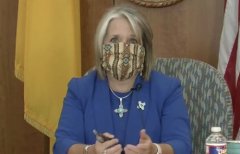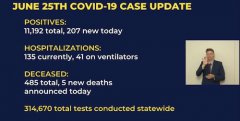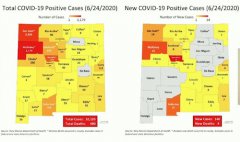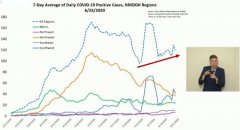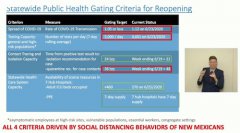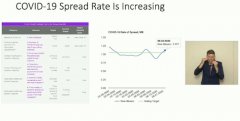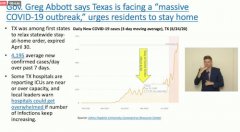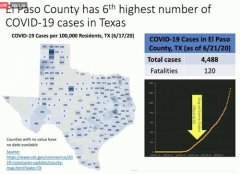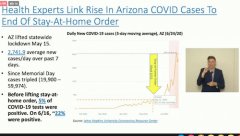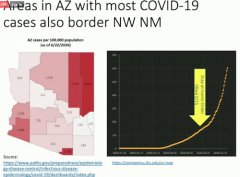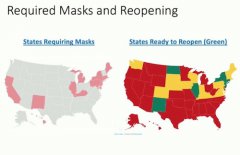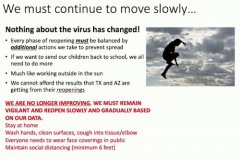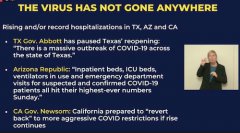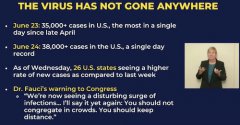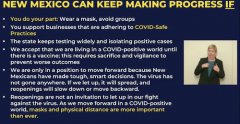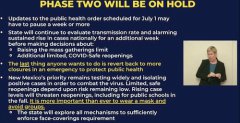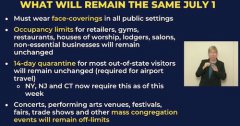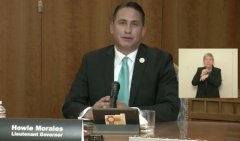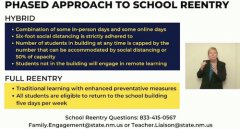By Hallie Richwine
MLG062520
MLG062520
Governor Michelle Lujan Grisham dons a mask made by Aurelia Davila of Ruidoso
http://www.grantcountybeat.com/images/2020newsitems/front-page-news/MLG-062520/slide01_062520.jpg
MLG062520
The case update
http://www.grantcountybeat.com/images/2020newsitems/front-page-news/MLG-062520/slide02_062520.jpg
MLG062520
Total cases and new cases
http://www.grantcountybeat.com/images/2020newsitems/front-page-news/MLG-062520/slide03_062520.jpg
MLG062520
What the current trending looks like
http://www.grantcountybeat.com/images/2020newsitems/front-page-news/MLG-062520/slide04_062520_.jpg
MLG062520
Where New Mexico stands against the gating criteria
http://www.grantcountybeat.com/images/2020newsitems/front-page-news/MLG-062520/slide05_062520.jpg
MLG062520
The increasing spread rate
http://www.grantcountybeat.com/images/2020newsitems/front-page-news/MLG-062520/slide06_062520.jpg
MLG062520
Information about Texas
http://www.grantcountybeat.com/images/2020newsitems/front-page-news/MLG-062520/slide07_062520.jpg
MLG062520
Prevalence in Texas
http://www.grantcountybeat.com/images/2020newsitems/front-page-news/MLG-062520/slide08_062520.jpg
MLG062520
Information about Arizona
http://www.grantcountybeat.com/images/2020newsitems/front-page-news/MLG-062520/slide09_062520.jpg
MLG062520
Prevalence in Arizona
http://www.grantcountybeat.com/images/2020newsitems/front-page-news/MLG-062520/slide10_062520.jpg
MLG062520
A possible correlation between wearing masks and meeting reopening criteria
http://www.grantcountybeat.com/images/2020newsitems/front-page-news/MLG-062520/slide11_062520.jpg
MLG062520
Going forward, moving slowly
http://www.grantcountybeat.com/images/2020newsitems/front-page-news/MLG-062520/slide12_062520.jpg
MLG062520
Living with the virus among us
http://www.grantcountybeat.com/images/2020newsitems/front-page-news/MLG-062520/slide13_062520.jpg
MLG062520
Living with the virus among us
http://www.grantcountybeat.com/images/2020newsitems/front-page-news/MLG-062520/slide14_062520.jpg
MLG062520
How we can do our part
http://www.grantcountybeat.com/images/2020newsitems/front-page-news/MLG-062520/slide15_062520.jpg
MLG062520
More data is needed to move onto phase two
http://www.grantcountybeat.com/images/2020newsitems/front-page-news/MLG-062520/slide16_062520.jpg
MLG062520
What remains the same
http://www.grantcountybeat.com/images/2020newsitems/front-page-news/MLG-062520/slide17_062520.jpg
MLG062520
Lieutenant Governor Howie Morales
http://www.grantcountybeat.com/images/2020newsitems/front-page-news/MLG-062520/slide18_062520.jpg
MLG062520
The hybrid model for students' return to school
http://www.grantcountybeat.com/images/2020newsitems/front-page-news/MLG-062520/slide19_062520.jpg
Governor Michelle Lujan Grisham opened the press conference by crediting the maker of her mask, Aurelia Davila of Ruidoso. Grisham said it is nice that some folks are able to share their craftsmanship while "we all combat COVID-19."
The topic of the conference is how to safely, slowly, and correctly reopen the state. Lieutenant Governor Howie Morales was present to show how this affects the reopening of schools.
"We're facing troubling issues. In fact, the last few days we've seen an uptick in cases. Monday there were 128, Tuesday 147, then Wednesday there were 156. We're seeing increases in every region," Grisham said." We can manage being flat, but our goal should be to reduce the number of cases." She said the reduction of cases means fewer deaths and fewer hospitalizations.
Dr. David Scrase shared the information about total cases and new cases in the state. The trend is more cases in the northeast, southeast, and Doña Ana county.
"The ages between 20-60 comprise 65% of all COVD-19 cases in the state. These are the more mobile, working folks," Scrase said. "The bad news is that trending is going up, and it's very concerning. The northwest is trending better but all other regions are trending upward."
Scrase said the gating criteria normally has five or six "green boxes", indicating the criteria is on goal. He noted this week there are more "red boxes," where the state isn't meeting its targets.
Scrase says the transmission rate is going up again. "This is a problem. We want it to be going down. The northwest is the only region that has stayed below target but they are improving," Scrase said.
Scrase shared the data and prevalence from neighboring Texas and Arizona. Both states are having massive outbreaks which may be attributed to earlier re-openings. "People relate more positive cases to more tests being given. But test positivity rate should stay the same or go down if we're testing more people."
He mentioned the possible correlation of masks and reopening. "I'm not saying it's perfectly correlated but half the states requiring masks are in the green as far as reopening. I believe wearing masks is related to stopping the spread of COVID-19. Nothing about the virus has changed, it's just a measure of our behavior."
"With any level of reopening, we have more contact. We need to be more careful. That doesn't mean we can relax our COVID-safe behaviors," Scrase said. "We have to be vigilant. If we want to reopen we need to be careful. Everyone should be wearing masks in public and maintaining distancing."
Grisham said "the more often we hear the information, the more likely we are to retain the information."
"The virus hasn't gone anywhere," she said. "We need to look at what's going on in the rest of the country. People are traveling in and out of states." She said people need to consider what the leadership is doing in the states that are having the spikes. "Texas is returning to stay at home orders. New Mexico has not lifted the state at home order; it's still in effect and it's the most effective way to stop the spread."
"In Arizona they have hit their highest numbers," Grisham said. "In California they are preparing to revert back to more aggressive COVID-19 restrictions." She said these states may have considerable impacts here and suggested limiting travel.
Grisham said another reason safety precautions have loosened could be that communications are diminishing, from the federal level down to the state level. "There are less updates and press conferences," she said, "That gave too many Americans a false sense of security."
"If we want our kids to go back to school, do your part. We owe it to every single student, their parents, and their educators," Grisham said. She urges New Mexicans to respect each other and help mitigate the spread.
"If you don't wear a mask, you don't support New Mexico businesses. Too many businesses are struggling. If we work hard to be safe when we support these businesses, this is how we keep them open," she said.
"The states that test widely and isolate positive cases are going to have the best impact on their economic recovery and getting back to school," Grisham said. "We have to accept we are living in a COVID-positive world and that requires vigilance. We're not going to be in a position to move forward until we're clear that the virus has not gone anywhere. It will slow opening or worse - we'll have to go backwards."
Grisham said at this point the state is not moving on to phase two. "That doesn't mean that we won't go to phase two, but we need more data. It depends on you."
Before turning the floor over to Morales, Grisham took a moment to recognize him. "Howie Morales is the only Lieutenant Governor in the country with a PhD in Education, as well as incredible experience and expertise," she said.
Morales released the plan for school reentry. "Among the principles we reviewed were keeping the safety and wellbeing of staff and students at the forefront. We also want to maximize in-person instruction." Morales said utilizing the data and modeling, "we are looking at a hybrid model for the beginning of the school year."
"This will split the in-person and online teaching. We will continuously monitor staff," he said. Rapid response and and surveillance testing will continue also.
The hybrid model gives the opportunity to have students in the classroom and see the impact on outbreaks. "We can also be responsive about full reentry, to ensure that if for whatever reason there is a spike or outbreak, we can return to the hybrid model," Morales said. "We're at this point today to talk about reentry because you have helped us work together to flatten the curve. There is still work to be done. We need to do all we can to keep each other safe, to do our part with simple things like social distancing, washing hands, and wearing masks."
"As for modeling, we looked at nearly fifteen models for reentry to school," Scrase said. "What's going to happen in schools has to do with what's happening in the community. I believe the hybrid model is the safest way to start the school year. If it does appear that it is safe, then at some point when the data looks good we can go to a four- or five-day week model."
Grisham said the goal isn't ultimately to be in the hybrid model, but that's "where we are and we need to respond to the pandemic in a meaningful way."
"The gating criteria allows us to make sure how slow the rate of the spread is, by monitoring the rate of infection. We want that to be low, and our testing capabilities to remain high," she said. "Then with effective surveillance and contact tracing we track the virus. The fourth category is monitoring the hospitalization rates so as not to overwhelm the health care system."
"We will treat schools like any opening entity. If there is an outbreak, we will close the facility and test until it's clear. The rapid response team will help when a positive case is found," she said.
